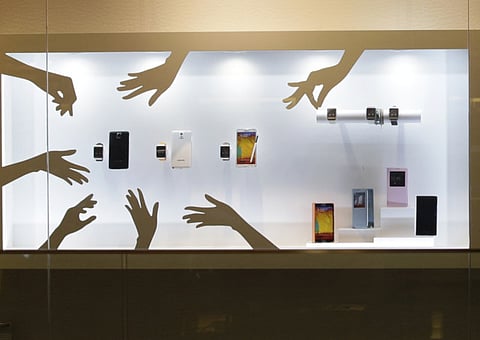Demand for phablets on the rise
The blurred lines between phones and tablets have propelled the multitasking phablets to fame

One of the most enduring technology legends concerns Bill Gates and his infamous quote about computer memory “640K ought to be enough for anybody”. Gates has admitted to making some stupid predictions, but has not rescinded this one. Equally ripe for entry into the hallowed ranks of ridiculous tech predictions is Steve Jobs’ 2010 pronouncement, on camera, that “no one’s going to buy” big phones. He believed that the iPhone’s 3.5-inch screen was the epitome of the “perfect size for consumers”. Unfortunately, consumers disagreed — rather emphatically. The latest report from Juniper Research, a mobile research specialist firm, predicts that by 2018, 120 million phablets will be shipped, up from the 20 million in 2013.
These numbers are on the lower side. Unlike most other analysts who consider anything above five inches to be a phablet, Juniper raises the bar to devices that have “a screen size between 5.6 inches and 6.9 inches and can still be held while making a phone call”. This distinction excludes two stellar hits from the Samsung stable — the original 5.3-inch Galaxy Note, which started the whole phablet craze and its follow-up, the Note II with a 5.5-inch screen. The debutant phablet reportedly sold around ten million units while its successor clocked up 30 million. The pace has only accelerated since then — Samsung’s current iteration, Note III with a 5.7-inch screen sold more than five million units within a month of launch.
No wonder Samsung’s roadmap for this year includes even more phablets. In a January earnings call, Hyunjoon Kim, Senior Vice-President of the mobile business, said that phablets is a category Samsung created. “We are the leaders in this segment. Each Note generation has greatly outsold the previous. This reflects market awareness that large smartphones equals Samsung,” he said. Elsewhere, consultancy firm Deloitte, which considers phones with five to 6.9-inch screens as phablets, expects that shipments of phablets will represent 25 per cent of all smartphones sold, working out to 300 million units this year. This is double last year’s volume and ten times the 2012 sales. The report adds, “Phablet revenues should be about $125 billion (about Dh459 billion), implying a $415 average selling price, which is about 10 per cent higher than for smartphones as a whole.”
Limits ahead
But Deloitte warns that 2014 may mark “a peak phablet year, as only a (sizeable) minority of smartphones users will want to handle such a large device”. The upper limit for phablets is pegged at 30-40 per cent of the smartphone market, which it should hit either this year or the next.
Juniper believes the maximum growth in the phablets category is coming from China and the Far East, while the Deloitte report adds, “In the second quarter of 2013, Asia-Pacific excluding Japan saw 25 million phablets sold – more than tablets or notebook computers.” Other markets that have seen dramatic increases include the Middle East, Singapore and India. In some regions, phablets even outsold TVs.
Deloitte Technology, Media and Telecommunications (TMT) predictions posits an interesting question: “Where do (phablet buyers) buy jeans big enough to fit their phablets?” Apparently, most will not have to upgrade their wardrobe — two-thirds of phablets sold in 2014 will be less than 5.1-inches. Only less than 10 per cent are likely to be six-inches or bigger.
According to Juniper Research, “The phablet market will likely grow from both ends of the price spectrum.” So whatever your budget, you are likely to find a phablet that fits in. It is also one device that dons two hats – that of a tablet and of a phone. Juniper Research also says, “The allure of a single device that can act with similar functionality to both a smartphone and a tablet will be more appealing in regions where the level of disposable income is lower.”
Two-fold appeal
In certain markets, phablets are looked upon as superior mobile gaming devices. In South Korea, Deloitte says, the large phablet screen is a leading choice for those who can’t afford or don’t want a console or PC gaming solution.
Also, in Asia, phablets are a great companion on the mass transit system commute, acting as an “all-in-one device that combines the features and functionality of a smartphone, portable gaming device, tablet and PC”.
Language explains the popularity of phablets too. Deloitte’s TMT Predictions report 2014 says, “Languages such as Arabic, Hindi, Chinese and Korean are more complex for a small screen and texting may be easier on the large screens and larger virtual keyboards of phablets.”
The biggest irony in the phablet saga is that there are strong rumours that this year Apple will reveal a large-screened iPhone. There might even be two versions, a smaller one to pacify the diehard fan, and a larger one to take on phablets from the Android camp. Apple CEO Tim Cook has neither denied nor confirmed these rumours. However, on the latest earnings calls he noted, “We’re working on things that are things that you see today, but we’re working [on] things that you can’t see today.” Cryptic as ever, but it sets the stage for the iPhablet.
Sign up for the Daily Briefing
Get the latest news and updates straight to your inbox



